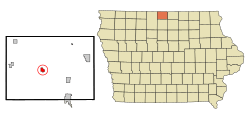Thompson, Iowa facts for kids
Quick facts for kids
Thompson, Iowa
|
|
|---|---|
| Motto(s):
A Good Place to Call Home
|
|

Location of Thompson, Iowa
|
|
| Country | United States |
| State | Iowa |
| County | Winnebago |
| Area | |
| • Total | 0.86 sq mi (2.22 km2) |
| • Land | 0.86 sq mi (2.22 km2) |
| • Water | 0.00 sq mi (0.00 km2) |
| Elevation | 1,270 ft (387 m) |
| Population
(2020)
|
|
| • Total | 495 |
| • Density | 577.60/sq mi (223.04/km2) |
| Time zone | UTC-6 (Central (CST)) |
| • Summer (DST) | UTC-5 (CDT) |
| ZIP code |
50478
|
| Area code(s) | 641 |
| FIPS code | 19-77745 |
| GNIS feature ID | 0462216 |
Thompson is a small city located in Winnebago County, Iowa, United States. In 2020, about 495 people lived there.
Thompson is known for hosting the annual Winnebago County Fair. It also has many farms and businesses related to agriculture. You can find a public swimming pool, the Thompson Museum, and the historic Bethany Lutheran Church, which was built in 1902.
Contents
Thompson's History and Growth
Thompson was officially planned out in 1892. It became an official city in 1894.
Early Services and Communication
A post office opened in Thompson in 1890. Mail delivery to homes in the countryside started in 1904.
The local newspaper, The Thompson Courier, began in 1894. It is still printed today. In 1938, it grew and became the Thompson Courier and Rake Register.
The first telephone system in Thompson was set up in 1894. Many small phone companies were started by farmers. They all shared one main switchboard in town. Later, a new company, the Winnebago Cooperative Telephone Association, brought modern phone service to the area.
Farming and Local Businesses
The Thompson Cooperative Creamery started in 1897. This creamery collected milk from several places nearby. They used machines to separate the cream, which was then cooled and churned into butter.
Farmers created the Farmers Cooperative Elevator Company in 1907. They wanted better prices for their crops. This company helped them store and sell their grain.
Thompson's Fire Department built its fire station in 1925. This helped keep the town safe from fires.
After some banks closed, a new one called The Peoples State Bank opened in Thompson on August 1, 1933.
Community and Infrastructure
The Thompson Public Library was created in 1937-1938. It was a project by a local club to improve the town. The library was in the Town Hall for 45 years before moving to the fire station in 1983.
In 1938, the Winnebago Rural Electric Cooperative was formed. This group brought electricity to homes and farms in the area. The first power lines were turned on in 1940.
Large cement buildings for storing grain were built in 1950 and 1967. These are called grain elevators. One of these elevators broke in 1983 and had to be taken down.
The old Chicago, Rock Island and Pacific Railroad train station on Main Street burned down in 1963. A smaller building replaced it until the train line closed in 1980.
In 1980, a big fire destroyed part of Main Street. This included the Branding Iron Supper Club, which later moved to a new building.
Thompson's Location
Thompson is located in Iowa. It covers an area of about 0.88 square miles (2.22 square kilometers). All of this area is land.
People Living in Thompson
| Historical populations | ||
|---|---|---|
| Year | Pop. | ±% |
| 1900 | 450 | — |
| 1910 | 500 | +11.1% |
| 1920 | 548 | +9.6% |
| 1930 | 538 | −1.8% |
| 1940 | 664 | +23.4% |
| 1950 | 698 | +5.1% |
| 1960 | 689 | −1.3% |
| 1970 | 600 | −12.9% |
| 1980 | 668 | +11.3% |
| 1990 | 498 | −25.4% |
| 2000 | 596 | +19.7% |
| 2010 | 502 | −15.8% |
| 2020 | 495 | −1.4% |
| Source: and Iowa Data Center Source: |
||
Population in 2020
In 2020, Thompson had 495 people living there. The city had about 577 people per square mile. About 92% of the people were White.
The average age in Thompson was 47.4 years. About 20% of the residents were under 20 years old.
Population in 2010
In 2010, there were 502 people living in Thompson. The city had about 570 people per square mile. Most of the people were White.
The average age in Thompson was 44 years. About 21% of the residents were under 18 years old.
Education in Thompson
The Thompson school district started in 1894. Thompson High School had its first graduating class in 1900. The last class graduated in 1989.
In 1909, a motorized school bus replaced the old horse-drawn one.
Today, Thompson is part of the North Iowa Community School District. This district was formed in 1996 by combining several smaller school districts.
Farms and Businesses in Thompson
Thompson has many important farms and businesses.
Linden Hill is a small farm that grows vegetables, honey, and herbs. They sell their fresh produce directly to the community.
Ovation Farms is a large farm that raises one million cage-free hens. They also have a feed mill and a plant to process eggs.
Horswell Potato Farms started in 1953. They were one of the first farms to wash and bag potatoes for stores. They also grew sugar beets. This farm was sold in 1968.
For travelers, Thompson has places like the Branding Iron Restaurant, Bucket's Bar and Grill, a Hometown Market, and a car wash.
Famous People from Thompson
- Clifford Branstad, a politician
- Judy Klemesrud, a journalist
See also
 In Spanish: Thompson (Iowa) para niños
In Spanish: Thompson (Iowa) para niños

